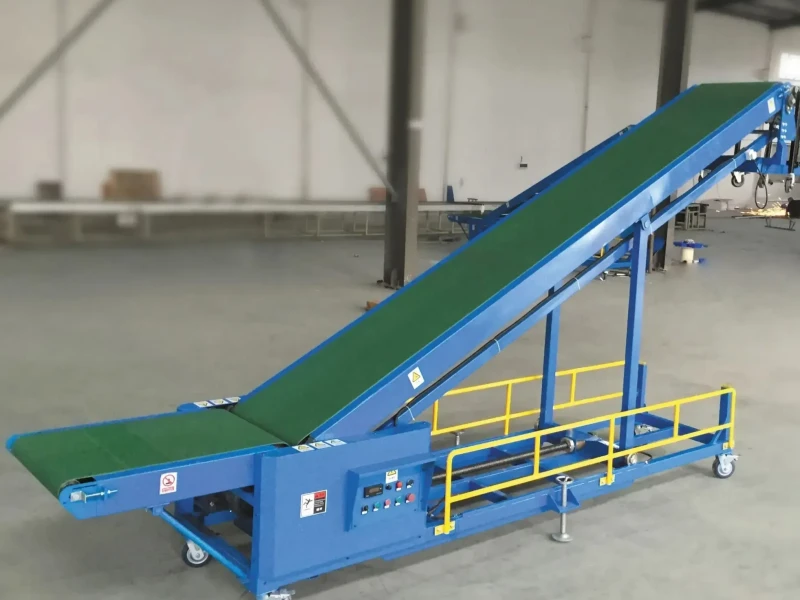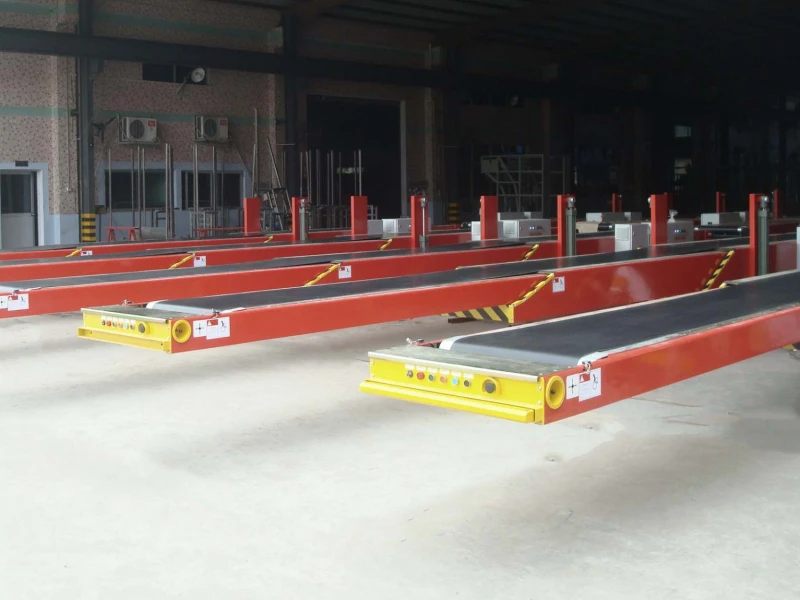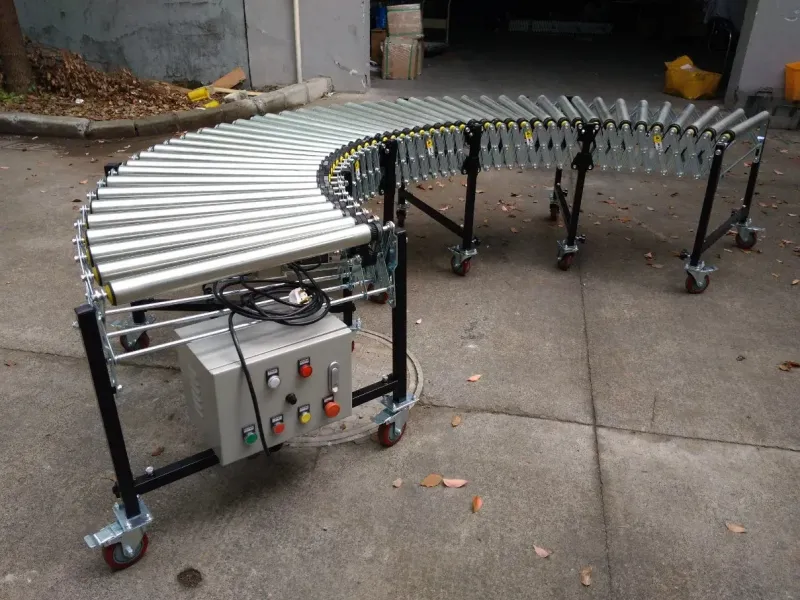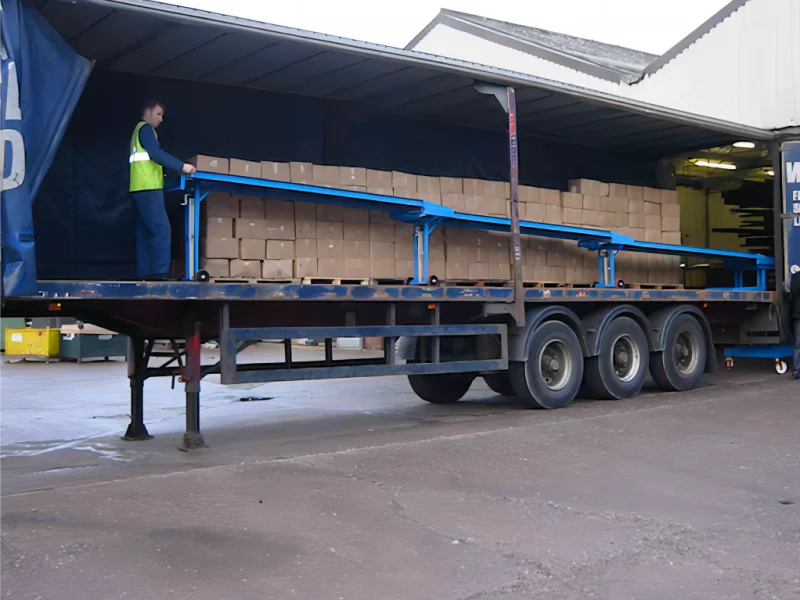
10 Benefits of Portable Conveyors for Unloading Trucks
In today's fast-paced logistics and material handling industries, efficiency and adaptability are crucial. Portable conveyors offer an innovative solution for unloading trucks, combining flexibility and mobility with robust performance. This guide explores the many benefits of using portable conveyors for truck unloading, providing insights into their types, components, and applications.
What is a Portable Conveyor?
A portable conveyor is a movable material handling system designed to transfer goods efficiently. Unlike fixed conveyors, portable conveyors can be relocated and adjusted according to operational needs, making them ideal for dynamic environments. Portable conveyors typically consist of a belt or rollers mounted on a wheeled frame, allowing easy movement and repositioning. Key features include adjustable height, variable speed controls, and lightweight yet durable construction.

This is a telescopic belt conveyor for truck unloading.
Types of Portable Conveyors
There are several types of portable conveyors, each suited to specific applications.
- Telescopic Belt Conveyors: Telescopic conveyors extend and retract to reach inside trucks, providing flexibility in loading and unloading operations.
- Portable Belt Conveyors: Mobile belt conveyors are versatile and can handle a variety of materials, making them suitable for different industries.
- Flexible Roller Conveyors: These conveyors can be bent and shaped to fit the unloading area, offering excellent adaptability.
Top 10 Benefits of Using Portable Conveyors
Portable conveyors offer numerous advantages, making them a valuable asset in material handling.
- Increased Efficiency
Portable conveyors streamline the unloading process, significantly reducing the time and effort required to transfer goods from trucks. - Reduced Labor Costs
By automating the movement of materials, portable conveyors reduce the need for manual labor, leading to lower labor costs. - Enhanced Safety
These conveyors minimize the physical strain on workers, reducing the risk of injuries associated with manual unloading. - Flexibility
Portable conveyors can be easily moved and adjusted to different locations and configurations, providing unmatched flexibility. - Cost-Effectiveness
The initial investment in portable conveyors is often lower than fixed systems, and their mobility allows for cost-effective use in various applications. - Space-Saving
When not in use, portable conveyors can be retracted or folded, saving valuable space in the facility. - Easy Installation
Portable conveyors require minimal setup and can be quickly deployed, reducing downtime. - Versatility
Suitable for a wide range of materials and environments, portable conveyors are versatile tools for many industries. - Durability
Built with high-quality materials, portable conveyors are designed to withstand heavy use and harsh conditions. - Environmental Benefits
Portable conveyors often consume less energy compared to other material handling systems, contributing to lower environmental impact.
Key Components of Portable Conveyors
Understanding the components of portable conveyors is essential for their proper use and maintenance.
- Belts: Belts are used in mobile belt conveyors to move materials. They are available in various materials to suit different types of goods.
- Rollers: Rollers are the primary components in flexible roller conveyors, facilitating the movement of materials.
- Frames: The frame holds the conveyor structure together. It must be robust and stable to support the conveyor's operation.
- Drive Mechanisms: Drive mechanisms power the movement of the belt or rollers, ensuring smooth and efficient operation.
How to Choose the Right Portable Conveyor
Selecting the appropriate portable conveyor involves several considerations.
- Load Capacity: Ensure the conveyor can support the weight of the materials being transported.
- Conveyor Length: Choose a conveyor length that matches the distance over which materials need to be moved.
- Belt or Roller Type: Select the appropriate belt or roller type based on the nature of the materials.
- Material Construction: The materials used in the conveyor should be suitable for the operational environment, such as corrosion-resistant materials for outdoor use.
Installation of Portable Conveyors
Proper installation is key to the effective operation of portable conveyors.
- Site Preparation: Prepare the site by ensuring it is clean, level, and free of obstructions.
- Assembly Instructions: Follow the manufacturer's instructions for assembling the conveyor components correctly.
- Safety Precautions: Implement safety measures such as securing the conveyor in place and ensuring emergency stops are accessible.
Applications of Portable Conveyors
Portable conveyors are used in various industries for diverse applications.
- Warehousing: Ideal for moving goods within warehouses and optimizing storage space.
- Manufacturing: Facilitate the movement of parts and products through different stages of production.
- Distribution Centers: Enhance the efficiency of loading and unloading goods in distribution centers.
- Retail: Assist in the movement of products from storage areas to the sales floor.
Portable Conveyors vs. Fixed Conveyors
Both portable and fixed conveyors have their advantages and are suited to different applications.
Portable conveyors offer mobility and flexibility, while fixed conveyors provide a permanent solution for high-volume operations. Portable conveyors are easier to install and move, but fixed conveyors are generally more robust and can handle higher capacities.

This is a flexible roller conveyor for truck unloading.
Technological Advancements in Portable Conveyors
Recent technological developments have enhanced the functionality of portable conveyors.
- Automation: Automated systems can control the movement of materials with minimal human intervention, increasing efficiency.
- Smart Sensors: Sensors can monitor the position and movement of materials, ensuring smooth operations.
- Integration with Warehouse Management Systems: Portable conveyors can be integrated with warehouse management systems for improved inventory tracking and order fulfillment.
Cost Analysis
Understanding the costs associated with portable conveyors can help in making informed decisions.
- Initial Investment: Consider the upfront cost of purchasing and setting up the conveyor system.
- Operating Costs: Factor in the costs of maintenance, energy consumption, and potential downtime.
- Return on Investment: Evaluate the long-term benefits and savings to determine the return on investment.
How to Optimize Portable Conveyors for Efficiency
Implementing best practices can maximize the efficiency of portable conveyors. Adopt strategies such as regular maintenance and employee training to ensure optimal performance. Proper training ensures that employees can operate and maintain the conveyors safely and effectively.
Safety Measures for Using Portable Conveyors
Safety is paramount when operating portable conveyors.
- Operator Training: Comprehensive training programs can prevent accidents and injuries.
- Equipment Safety Features: Ensure that conveyors are equipped with necessary safety features like emergency stops and guards.
- Emergency Procedures: Establish clear emergency procedures to handle any incidents promptly.
Customizing Portable Conveyors for Specific Needs
Customization can tailor portable conveyors to meet specific operational requirements.
- Tailor-Made Solutions: Work with manufacturers to design conveyors that fit your unique needs.
- Industry-Specific Requirements: Different industries have different requirements; ensure your conveyor system is suited to your specific industry.
FAQs about Portable Conveyors for Unloading Trucks
1. How do portable conveyors work?
Portable conveyors use belts or rollers to move materials efficiently from one location to another, often with adjustable height and speed settings.
2. What are the benefits of portable conveyors for unloading trucks?
They increase efficiency, reduce labor costs, enhance safety, and offer flexibility and cost-effectiveness.
3. How do you maintain portable conveyors?
Regular inspections, proper lubrication, and prompt troubleshooting of issues are essential.
4. What factors should be considered when choosing a portable conveyor?
Consider load capacity, conveyor length, belt or roller type, and material construction.
5. Can portable conveyors be customized?
Yes, they can be tailored to meet specific operational and industry requirements.
6. Are portable conveyors environmentally friendly?
Modern portable conveyors are designed to be energy-efficient and have a lower environmental impact compared to other material handling systems.
Portable conveyors are a game-changer in the realm of material handling, particularly for unloading trucks. Their flexibility, efficiency, and ease of use make them an invaluable asset across various industries. By understanding their benefits, components, and best practices, businesses can optimize their operations and improve productivity. As technology continues to evolve, portable conveyors will offer even greater capabilities, ensuring they remain a cornerstone of efficient material handling.



Leave Me Your Requirement!